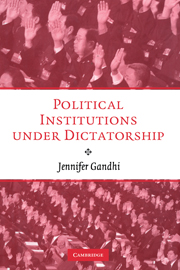Book contents
- Frontmatter
- Contents
- List of Tables and Figures
- Acknowledgments
- Introduction
- 1 The World of Dictatorial Institutions
- 2 Three Illustrative Cases
- 3 Use of Institutions to Co-opt
- 4 Institutions and Policies under Dictatorship
- 5 Institutions and Outcomes under Dictatorship
- 6 Institutions and the Survival of Dictators
- 7 Conclusion
- 8 Codebook of Variables
- Bibliography
- Author Index
- Subject Index
2 - Three Illustrative Cases
Published online by Cambridge University Press: 25 July 2009
- Frontmatter
- Contents
- List of Tables and Figures
- Acknowledgments
- Introduction
- 1 The World of Dictatorial Institutions
- 2 Three Illustrative Cases
- 3 Use of Institutions to Co-opt
- 4 Institutions and Policies under Dictatorship
- 5 Institutions and Outcomes under Dictatorship
- 6 Institutions and the Survival of Dictators
- 7 Conclusion
- 8 Codebook of Variables
- Bibliography
- Author Index
- Subject Index
Summary
INTRODUCTION
The aggregate numbers show that nondemocratic regimes display significant heterogeneity. The variation in institutions and the reasons for it come into sharper focus by examining some specific cases. First, consider Kuwait. Beginning in the early 1900s, merchants were active in the political life of the kingdom. They rebelled against the emir's unilateral imposition of taxes and demanded greater participation in decision-making alongside the Sabah ruling family. Dependent on the merchants for revenues, the emir steadily granted concessions, culminating in a parliament in 1938. The institution, however, did not last. As Kuwaiti rulers were able to disentangle themselves from the merchants through steadily increasing oil revenues and to consolidate and distribute power within their family, they were able to cease concessions to the merchants who eventually, themselves, were co-opted.
The kings of Morocco, however, were not able to avoid making concessions to outside groups. After independence from France in 1956, they sought the cooperation of their citizens in state-building because they had little recourse to external revenues. In addition, a secular, nationalist party that had gained popularity for its leading role in the independence movement foiled the monarchs' designs to consolidate absolutist power. As a result, nominally democratic institutions emerged with the king forced to contend with parliaments containing parties that did not always follow his will.
- Type
- Chapter
- Information
- Political Institutions under Dictatorship , pp. 42 - 72Publisher: Cambridge University PressPrint publication year: 2008

